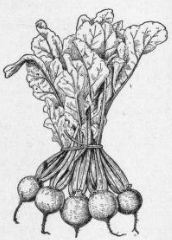325. Marketing Beets
Description
This section is from the book "Vegetable Gardening", by Ralph L. Watts. Also available from Amazon: Vegetable Gardening.
325. Marketing Beets
Early beets are usually sold on local markets before they have attained full size, because the market accepts a small tender beet, and the grower desires to clear the land as soon as possible for some other crop. A few days' delay often makes a great difference in market prices, and growers for local markets find that it usually pays to dispose of the small beets as soon as dealers will take them.
The early beets are tied in bunches of three to ten, depending upon size and market requirements (See Figure 64). Washing is usually done after bunching. Bunched beets are shipped from the South in cabbage crates or other convenient, well-ventilated packages.
When prices decline, beets are sold in bulk, the tops being cut about an inch from the crown and the roots packed in baskets, boxes or crates, and barrels.
In sandy soils beets are easily pulled by hand; in heavy land a one-horse plow can be used to advantage in this work.
The late crop may be stored in various ways. Burying is a popular method. Cellars and pits are often used, the roots being covered with moist sand or soil if the air is dry.

Fig. 64. beets bunched for market.
Yields and returns are variable. A yield of 300 to 400 bushels an acre is considered good for garden beets, although larger crops have been harvested. Gross receipts range from $200 to $600 an acre.
Continue to:
Tags
plants, crops, gardening, cultivated, harvesting, food ,greenhouses, fertiliser, vegitables
